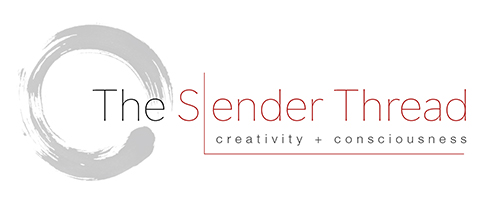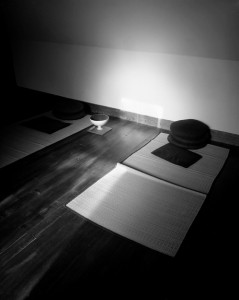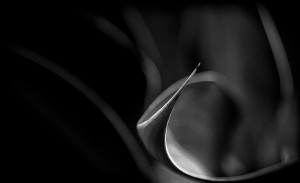This is the teaching of yoga.
Yoga is the cessation of the turnings of thought.
When thought ceases, the spirit stands in its true identity as the observer to the world.
Otherwise, the observer identifies with the turnings of thought.
Perhaps one of the purposes of the sutras, like creativity, is to get us deep inside ourselves so that we can start to become intimate with who we really are underneath the layers, our mental vascillations, citta vritti, and all those samskaras. (psychological grooves) Practice, then should be done with the intention of learning how to watch when those latent impression rise up and fight for survival.
What does it mean to watch, to observe oneself? What inner direction must be taken to approach the “cessation of the turning of thoughts?” We know, from experience, that we cannot completely stem the tide of noisy thinking. Yet, perhaps a direction can be found through merely suspending our attention to the thoughts, merely allowing them to be, and moving inward, into the body, into a still center point. Yoga knows this suspension of our attention on the thoughts as “nirodha’. The creative individual knows intuitively that the surface mind must be transcended to find the creative force within oneself. Creativity and yoga can be activities that encourage the steadiness of the attention and open to the silence within.
James Traverse writes: “nirodha is the silence that is always available and is when fragmentation has ceased; it is authentic silence …”
**********
“It is my belief that creativity arises from stillness.” These were the initial words spoken in my first creative photography class in college. Forever impressed upon my memory is not only the words themselves, but how they were spoken.
As we entered the classroom, the person we sensed to be the teacher was already there, sitting quietly on a cushion in a meditative posture, eyes closed, looking like a still Buddha in the front of the room. We overtook the space with a noisy enthusiasm. We were surprised and interested; the individual on the cushion stayed there, with grace and naturalness. It took several minutes for us to settle, but gradually a quiet began to overspread the room. Something shifted — a vibration perhaps, an inner tone in the room. At that moment, Nicholas Hlobeczy opened his eyes, surveyed the group of us, and with a measured, resonant voice made his proclamation: that creativity arises from stillness. He offered no explanation at the time. We merely began the class, but that initial moment reverberated for some time after. It was a means of helping us enter the present moment, it was the first intimation of a teaching on art and creativity — and it was a form of theatre. It definitely made an impression.
What could he mean? Surely he must know that contemporary life was anything but still. Art, music, entertainment, and film were deeply infused with the vital and driving energies of the modern world. Surely he did not want us to ignore the pace and complexity of our lives. Surely he was not asking us to retreat from the compelling social conditions and conflicting politics of the day.
Fortunately, he allowed us to live with these questions for a while. His words acted on us. Over time, we began to understand something of their resonant meaning. We began to recognize that all activities can arise from a still point. I imagined the embers of a fire, glowing quietly, emitting radiant energy regardless of the force and intensity of the flames themselves.
We learned that Nicholas intended for us to discover and develop contact with a still point within. We learned that he wished to introduce us to inner quiet, allowing our actions to arise naturally from deep within ourselves. We learned that he wanted to help us cultivate a space within to receive impressions of ourselves, the outer world, and of photographic images fully, vividly, and directly. We learned that he distrusted the incessant inner dialogue and noisy turning of the mind, and that he doubted the value of the unremitting emotional reactions we have to everything around us. We learned that he deeply respected the natural intelligence of the body, the understandings available through the feeling nature, and the discoveries made through the mind’s depth. We understood that he appreciated the many active rhythms and energies of photography — walking around the world, learning to see, attending to the mechanics of the camera, and participating in the alchemy of the darkroom. Over time, we learned that leaving space within, developing a quiet inner attention, deepening our vision — and opening to the search for our true nature — were his primary goals. And all of these referred back to his initial, many-layered proclamation at the start of the class.
We understood, for the first time really, that inner stillness was not incompatible — was in fact highly complementary — with living our lives with vigor, passion, commitment, and relatedness with the world. As we wanted our creative work to be a true reflection of ourselves and the world around us, the mirror itself had to be polished and still.
The class was vital and exciting. We began to view art and photography as a genuine practice — of how to live our lives. Illumined by our youthful efforts, we had glimpses of creativity as a way of life. We received many new and nourishing impressions through our work with a camera, our response to each other’s images, and the many exercises of attentive perception that Nicholas brought to the classroom. He simply helped us leave space within for natural learning to occur.
Adapted from Art and Spiritual Practice by David Ulrich and Laura Dunn Yoga Blog.
links



Hello man! I quite agree with your thoughts.